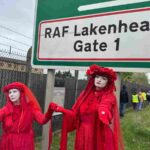Israel’s barbaric appetite for killing knows no bounds – its genocidal mission continues to escalate in intensity as its stomach is stretched ever deeper, its pangs of murderous hunger induced by the war mongering of Western imperialism. As Israel’s siege on Gaza is prolonged and intensified, the rate and quantity of their emissions grow too.
To understand the very real implications of war and militarism on climate, as well as the ways in which militarism, conflict, and conquest are situated at the very core of the climate crisis, then we must turn our gaze to the colonial and post-colonial world.
Here we must assess the deliberate undoing of the natural world alongside the primitive accumulation and brutality which has ushered in the capitalocene– an era of turmoil, uncertainty and impending doom brought about by the capitalist mode of production and its creation and reproduction of the conditions which threaten the existence of all life on this planet.
Gaza: a mediaeval siege and the climate catastrophe
As an enduring project of European settler colonialism and as the front on which Western imperialism, and US imperialism in particular, is showing its ugly teeth at this current moment – it is fitting that we begin this analysis with our gaze locked on Gaza and the rest of occupied Palestine.
We have all seen the nightmarish brutality of Israel’s mediaeval siege on Gaza – involving the relentless and indiscriminate bombing of the strip, the implementation of a harsh blockade of supplies and aid – including food, water, fuel and medical supplies, and the deployment of thousands of occupation soldiers.
The human cost of this genocidal onslaught is already unconscionable – it is both nauseating and infuriating. Added to our collective feelings of gloom in this moment is the lasting and widespread environmental cost of Israel’s attack.
Globally, communities across the Global South are already reeling, and have been for decades, from the climate impacts of militarised imperial aggression. Israel’s contribution to this, both historically and in the current moment, are worthy of condemnation.
Fuelling emissions via the war machine
In a recent article published by the Guardian, it is reported that in the first 60 days of the siege alone (now stretching into its fifth month) – the Israeli occupation forces (IOF) emitted over 281,000 metric tons of carbon – which is already far higher than the annual emissions of many countries in the Global South.
This is a conservative underestimation and does not account for the emissions of the entire industrial supply chain which feeds the Israeli death machine. Many experts place their estimations far higher.
These figures should shock all of us, especially at a time when the world so desperately needs to reduce emissions and align its priorities with the needs of ordinary people if it is to avoid the worst of the unfolding climate disaster.
Beyond the emissions of the military apparatus and machinery itself, the actual bombing and destruction of infrastructure, coupled with the ground invasion and displacement of about 85% of the population in Gaza, has resulted in the complete disruption of normal life.
Destroying life in Gaza
Where infrastructure has not been destroyed as a direct result of the shelling and bombing, the deliberate unravelling of Gaza’s social fabric has led to the collapse of waste management systems including water treatment, water pumps, sanitation, and desalination facilities. This has resulted in sewage flowing through the streets, seeping into the land and flowing into the sea – spreading water borne illnesses like typhoid, cholera and hepatitis while obviously having a devastating impact on ocean ecosystems.
Added to this of course, is the destruction of tens of thousands of buildings in Gaza – with the strip levelled almost entirely to a landscape of debris. This, alongside the usage of chemical weapons such as white phosphorus, has been incredibly polluting of both the air and water and has created a toxic environment that all Gazans are unavoidably exposed to. The carbon cost of rebuilding would also be immense.
To make matters worse, it’s been reported that since 1967 the Israeli occupation forces and settler militias have illegally uprooted more than 800 thousand olive trees across occupied Palestinian territories. These olive trees are not only a sacred part of land-stewardship practices but are also a vital carbon sink.
Each olive tree plays a role in absorbing CO², in preventing soil erosion, and of course in bolstering food security. This sort of damage to Palestinian land is further compounded by Israeli bans on imports of things like steel pipes – which are vital for wastewater treatment. The lack of this sort of infrastructure has meant that huge amounts of sewerage has been seeping into the Mediterranean for many years already.
A deliberate manufacturing of frontlines
There are many many more examples that can be drawn out here – the important point however, is to assert that the environmental crisis which can be observed across occupied Palestine is a crisis that has been deliberately manufactured by the machinery of war. Likewise, the Palestinian people are a people who find themselves incredibly vulnerable to the worsening crisis of climate precisely because of the war that Israel has waged on them.
Their ability to mitigate and to develop mechanisms to offset the worst impacts of the climate crisis have been completely and deliberately undermined while the resources and infrastructure they would need to meet the crisis have, in very real terms, either been destroyed or stolen – as part of a calculated attempt to eradicate the Palestinian people and erase their culture, their knowledge, their land, and their history.
Palestinians in Gaza and across the occupied territories have not aimlessly wandered and found themselves, by some act of random chance, to be in what we would call ‘frontline communities’.
They are not simply living as vulnerable people who stand to face the worst impacts of the climate crisis just because they happen to be on the frontlines.
No, the frontlines themselves have been manufactured – the Palestinian people have been made to live on the frontlines – their conditions have been imposed onto them by their oppressor.
This is an important distinction to make when we draw out the links between war, imperialism, conflict, and conquest – and the realities of climate collapse. In many ways, what we have described in Palestine resonates with the reality of the broader colonial and postcolonial world.
Colonialism and post-colonialism and the climate crisis
We often talk about how the climate crisis stands to impact the poorest, most vulnerable and most marginalised members of our global society – specifically those in the Global South and in Diaspora communities. Indeed, it is true that those who contributed the least will suffer the most.
What we must never fail to forget however is the fact that the most vulnerable and marginalised people are not simply the most vulnerable and marginalised by some sort of innate natural phenomenon- they were not destined to be vulnerable. The position that they find themselves in is one that has been imposed onto them by the design, calculated implementation, and methodical reinforcement of oppression.
The colonial systems and methodologies of exploitation, extraction, oppression, subjugation, and violence which destroyed Indigenous societies, enslaved and murdered millions of people, and entrenched the lasting legacies of inequality, exclusion, poverty, violence, and strife are the very same systems and methodologies which have destroyed ecosystems across the Global South in pursuit of profit through the extraction of fossil fuels and other natural resources which have been used historically, and up until now, to spur the economic and military might of empire.
The Democratic Republic of the Congo
Take the Democratic Republic of the Congo (DRC). Here you have a stark example of how colonial conquest and extraction has profoundly shaped the historical and contemporary landscape and trajectory of an entire country and people. Under colonial Belgium the Indigenous People of what was then the Belgian Congo were subjected to what is arguably one of the most brutal and deadly systems of oppression that has ever existed.
This violent oppression at the hands of King Leopold II, which saw up to 10 million people killed, was committed in order to extract the country’s natural wealth and exploit the slave labour of the Indigenous People. It is to this primitive accumulation, which was occurring across the African continent and colonised world, that the relative stability and comfort of many societies across the global north today can be credited. All the while over 25 and a half million people in the DRC are experiencing emergency levels of food insecurity.
Their hardship and strife in the world today is not merely a lasting legacy of what some (at least those who seek to erase their sins alongside the erasure of history) may describe as a distant colonial past. Nor is it, as liberals love to argue, a result of weak institutions and poor governance. It is an ongoing crisis of colonialism and imperialism which has expressed itself through the deliberate and calculated destabilisation of the post-colonial DRC.
A calculated destabilisation
This calculated destabilisation is evidenced in the murder of Patrice Lamumba – which many decolonial and liberation thinkers attribute to Belgium’s desire to protect their mining interests after the collapse of their direct colonial rule and America’s fear that the spread of opposition to their global hegemony would present a challenge to the violent capitalist system in which their dominance is rooted. From the time of his murder, until today, the greedy hand of empire has not let loose its evil grip on the Congo. It remains as violent and unrelenting as ever – no matter how civilised and measured it may opt to present itself.
It is within this “post-colonial” context that the DRC remains in shackles – a playground for imperial interests – where multinational corporations fund and fuel conflict in order to maintain access and control over resources while ensuring the people remain desperate enough to give their labour to warlords and corporations for a pittance.
Even the so-called peace-keeping forces deployed to the DRC are there primarily to protect the interests of mining capital. We see the same situation in Mozambique, where the gas interests of Total and others are protected with the might of state militaries and private mercenary armies alike.
Inseparable issues
Again, there is a lot more that can be said – and many more examples that can be made from across the African continent and the global south and diaspora communities. Without needing to expound on them all in significant detail, the common feature is found in the fact that militarism and war, and more specifically the violence of oppressive powers, are inseparable from the crisis of climate.
Not only do they contribute enormously to the worsening of climate collapse through their emissions, but of course increased militarisation is used to protect the interests of fossil fuel corporations. Likewise, wars and conquests – from the colonial period and through to our current moment – are often undertaken with the expressed or hidden intention of securing natural resources and especially fossil fuels. I mean, all you need to do is look at the Iraq war and how it was hugely incentivised by the US’s oil interests.
What becomes important in our perspectives here then, is to always remind ourselves of the centrality of the military machinery of oppression in any analysis we might make in relation to the disproportionate burdens and impacts of the climate crisis and the manufactured conditions of the frontline communities that we centre in our pursuit of climate justice.
No climate justice without liberation
In recognition of this, and with full acknowledgement that the root causes of the climate crisis are intrinsically linked to the historical injustices wrought by colonial powers, we must assert in the clearest possible terms that climate justice, in its truest form, cannot be realised without the comprehensive and radical liberation from the enduring shackles of colonialism and imperialism.
Achieving climate justice then necessarily requires that we work to dismantle all oppressive structures, systems, and logics. In this current moment, that requires the entirety of the climate justice movement to pledge its undying support to the cause of Palestinian liberation and to further commit itself to the liberation of all oppressed peoples. Only then can we pave the way for a just and sustainable future – one where environmental well-being is inseparable from social and economic justice.
At its core, our struggle for climate justice is a fight to dismantle all from all forms of exploitation and oppression. It is a banner under which to rally the marginalised and oppressed toward the freedom of all peoples and the construction of a world that is entirely and fundamentally just in every sense of the word.
Featured image via Yousef Masoud/SOPA Images/Sipa USA



















